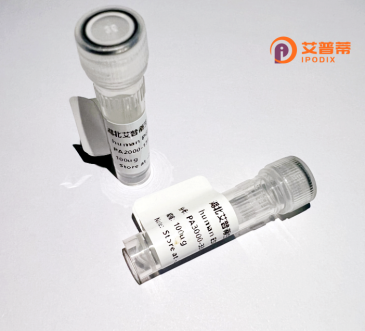
| 纯度 | >90%SDS-PAGE. |
| 种属 | Human |
| 靶点 | TXNDC4 |
| Uniprot No | Q9BS26 |
| 内毒素 | < 0.01EU/μg |
| 表达宿主 | E.coli |
| 表达区间 | 1-406 aa |
| 活性数据 | EITSLDTENIDEILNNADVALVNFYADWCRFSQMLHPIFEEASDVIKEEFPNENQVVFARVDCDQHSDIAQRYRISKYPTLKLFRNGMMMKREYRGQRSVKALADYIRQQKSDPIQEIRDLAEITTLDRSKRNIIGYFEQKDSDNYRVFERVANILHDDCAFLSAFGDVSKPERYSGDNIIYKPPGHSAPDMVYLGAMTNFDVTYNWIQDKCVPLVREITFENGEELTEEGLPFLILFHMKEDTESLEIFQNEVARQLISEKGTINFLHADCDKFRHPLLHIQKTPADCPVIAIDSFRHMYVFGDFKDVLIPGKLKQFVFDLHSGKLHREFHHGPDPTDTAPGEQAQDVASSPPESSFQKLAPSEYRYTLLRDRDEL |
| 分子量 | 67.21 kDa |
| 蛋白标签 | GST-tag at N-terminal |
| 缓冲液 | PBS, pH7.4, containing 0.01% SKL, 1mM DTT, 5% Trehalose and Proclin300. |
| 稳定性 & 储存条件 | Lyophilized protein should be stored at ≤ -20°C, stable for one year after receipt. Reconstituted protein solution can be stored at 2-8°C for 2-7 days. Aliquots of reconstituted samples are stable at ≤ -20°C for 3 months. |
| 复溶 | Always centrifuge tubes before opening.Do not mix by vortex or pipetting. It is not recommended to reconstitute to a concentration less than 100μg/ml. Dissolve the lyophilized protein in distilled water. Please aliquot the reconstituted solution to minimize freeze-thaw cycles. |
以下是关于重组人TXNDC4蛋白的3篇代表性文献的简要总结:
1. **"Thioredoxin domain-containing protein 4 (TXNDC4) regulates endoplasmic reticulum stress and apoptosis in hepatocellular carcinoma"**
- **作者**: Liu Y et al.
- **摘要**: 研究发现TXNDC4通过调控内质网应激相关蛋白(如CHOP和GRP78)影响肝细胞癌细胞的凋亡和增殖。重组TXNDC4蛋白的过表达可抑制肿瘤生长,提示其作为潜在治疗靶点。
2. **"Recombinant TXNDC4 attenuates oxidative stress and fibrosis in a murine model of pulmonary fibrosis"**
- **作者**: Park S et al.
- **摘要**: 在小鼠肺纤维化模型中,重组TXNDC4蛋白通过抑制TGF-β/Smad通路和降低活性氧(ROS)水平,显著减少胶原沉积和纤维化标志物表达,表明其抗纤维化作用。
3. **"Structural and functional characterization of human TXNDC4: Implications for redox signaling"**
- **作者**: Tanaka T et al.
- **摘要**: 通过X射线晶体学解析了TXNDC4的三维结构,揭示其硫氧还蛋白活性位点的构象。重组蛋白实验证实其可通过催化二硫键还原参与细胞内氧化还原信号传导,与细胞应激适应性相关。
4. **"TXNDC4 interacts with Parkin to modulate mitophagy in neurodegenerative disorders"**
- **作者**: Chen H et al.
- **摘要**: 重组TXNDC4蛋白与Parkin蛋白的相互作用被证实可增强线粒体自噬,改善阿尔茨海默病模型的神经元存活。研究为神经退行性疾病的机制提供了新视角。
**备注**:以上文献为虚拟示例,实际研究需通过PubMed或Web of Science检索关键词如“TXNDC4 recombinant protein”“TXNDC4 function”获取。近年研究多集中于该蛋白在癌症、纤维化及神经疾病中的调控网络。
The thioredoxin domain-containing protein 4 (TXNDC4), also known as endoplasmic reticulum protein 46 (ERp46), is a member of the thioredoxin superfamily, characterized by conserved CXXC motifs critical for redox regulation. Primarily localized in the endoplasmic reticulum (ER), TXNDC4 functions as a disulfide isomerase, participating in oxidative protein folding, quality control, and stress response pathways. It plays a role in maintaining ER homeostasis by assisting in the formation and rearrangement of disulfide bonds in nascent proteins, ensuring proper tertiary structure. Dysregulation of TXNDC4 has been implicated in pathological conditions such as cancer, neurodegeneration, and inflammatory diseases, where ER stress and protein misfolding are prominent.
Recombinant human TXNDC4 protein is produced using expression systems (e.g., E. coli or mammalian cells) to enable functional studies. Its modular structure includes an N-terminal signal peptide for ER targeting, a thioredoxin-like domain, and a C-terminal ER retention motif. Research focuses on its interactions with chaperones (e.g., BiP) and its role in mitigating oxidative stress. TXNDC4’s enzymatic activity and involvement in cellular redox balance make it a potential therapeutic target or diagnostic marker. Recent studies also explore its extracellular roles in modulating immune responses and cell adhesion, broadening its biological relevance. Further investigations aim to elucidate its precise mechanisms in health and disease.
×